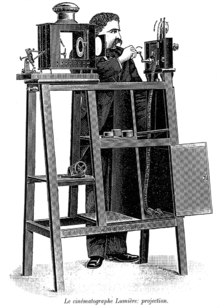User:AmyBesser/testentry
This article needs additional citations for verification. (January 2009) |

A cinematograph is a motion picture film camera, which also serves as a film projector and developer. It was invented in the 1890s.[notes 1]
There is much dispute as to the identity of its inventor. Some argue[who?] that the device was first invented and patented as "Cinématographe Léon Bouly" by French inventor Léon Bouly on February 12, 1892. Leon Bouly coined the term “cinematograph”, which translates in Greek to “writing in movement”. [1] It is said that, due to a lack of fee, Bouly was not able to pay the rent for his patent the following year, and Auguste and Louis Lumière's engineers bought the license.
Popular thought, however, dictates that Louis Lumière was the first to conceptualise the idea, and both Lumière brothers shared the patent. They made their first film, Sortie de l'usine Lumière de Lyon, in 1894. The film was publicly screened at L'Eden, the World's first and oldest cinéma, located in La Ciotat in southeastern France, on September 28, 1895. The first commercial, public screening of cinematographic films happened in Paris on 28 December 1895 and was organised by the Lumière brothers.[2] The cinematograph was also exhibited at the Paris Exhibition of 1900. At the Exhibition, films made by the Lumiere Brothers were projected unto a large screen measuring 16 by 21 meters (approximately 52.5 x 69 feet). [3]
thumb|right|The cinématographe Lumière in filming mode.
Several versions of cinématographes were developed, including ones by Robert Royou Beard, Cecil Wray, Georges Demenÿ, Alfred Wrench, and that of the Lumière brothers.[4]
The cinematograph is sometimes associated with the “birth” of cinema or the dawn of a new age of film that replaced the pre-cinema era.[1]
Invention[edit]
Louis Lumiere worked with his brother Auguste to create a motion picture camera superior to Edison’s kinetoscope. The Lumières endeavored to correct the flaws they perceived in the kinetoscope to create a machine capable of both sharper images and better illumination. The Cinématographe weighed only 16 lbs. which allowed for ease of transportation and placement. As well, the cinematograph was manually operated by a hand-crank, opposed to Edison’s electrically powered camera which could not be transported in any way. Furthermore, while Edison’s kinetoscope could only be viewed by one person at a time through an eye piece, peepshow style, the cinematograph could be projected onto a screen to be viewed by a large audience of people simultaneously. [5]
The cinematograph produced a sharper projected image than had previously been seen before due to its design, which a kind of fork held the film reel in place through the perforations made on the sides of the film strip . In 1897, the Lumières further added to their invention with a device intended to work as a condenser and to prevent overheating of the film after extended use. A glass flask of water was placed in the projector, which also acted as a block system, as it would disrupt the concentration of light unto the film if the glass were to break. [3]
Popularity[edit]
The cinematograph became a popular attraction and pastime for people all over the world. The Lumiere Brothers took their machine as far and wide as China and India.[5] Movies shown through its projector were enjoyed by people of all classes and social standings. The cinematograph was used to show films in nickelodeons, where even the poorest classes could obtain the entry fee. It was exhibited at fairs and used as entertainment acts in vaudeville houses in both Europe and the United States. While vaudeville is typically associated with the middle class of people, the machine also found its way into more sophisticated venues, where it appealed to the artistic tastes of high society. [1]
The cinematograph was first displayed in England on February 20th, 1896. On June 29th, 1896, the Lumière’s cinematograph had its first screening in the United States. The exhibition took place at Keith’s Union Square Theater in New York City, NY. Four weeks after its initial debut, a second cinematograph appeared in the United States, this time in Philadelphia. The cinematograph replaced a rival invention, the vitascope, at Keith’s Bijou Theater.These machines proved to be popular and soon after, the cinematograph found its way onto the vaudeville theater circuit, finding a vast audience in the American public.[6]
See also[edit]
- Biograph
- Electrotachyscope
- Film
- Image
- Kinetoscope
- List of film formats
- Panoptikon
- Pleograph
- Praxinoscope
- Vitascope
- Zoopraxiscope
References[edit]
- ^ Note that this was not the first 'moving picture' device. Louis Le Prince had built early devices in 1886. His 1888 film Roundhay Garden Scene still survives.
- ^ a b c Abel, Richard. Encyclopedia of Early Cinema. 1st ed. London: Routledge, 2004.
- ^ Louis Lumiere, The Lumiere Cinematograph. In:Fielding, Raymond (1979). A technological history of motion pictures and television: an anthology from the pages of the Journal of the Society of Motion Picture and Television Engineers. University of California Press. pp. 49–51. ISBN 0-520-03981-5.
- ^ a b Cinematograph, Louis Lumière. “1936 the Lumière Cinematograph.” SMPTE Journal 105, no. 10 (October 1, 1996): 608–611.
- ^ "Machines". Who's Who of Victorian Cinema. British Film Institute.
- ^ a b Gomery, Professor Douglas, and Clara Pafort-Overduin. Movie History: A Survey. Taylor & Francis, 2011.
- ^ Musser, Charles. The Emergence of Cinema: The American Screen to 1907. University of California Press, 1994.
External links[edit]
Category:Auguste and Louis Lumière Category:History of film
